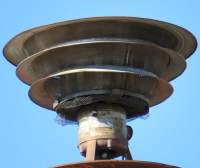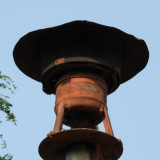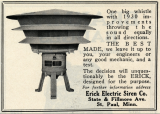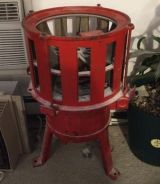Erick Fire Siren
| Erick Fire Sirens | |
 An inactive 12-port Erick Fire Siren, located in Cecil, WI. Photo credit to Tom Diener. | |
| Company | Erick Electric Siren Co. |
|---|---|
| Produced | Early 1920s-1940s |
| Type | Omnidirectional Electromechanical |
| Sound output | - |
| Horsepower | 2-10 hp |
The Erick Fire Siren is an omnidirectional mechanical siren that was produced by Erick Electric Siren Co. based out of St. Paul, MN. It was designed for use at fire stations to call volunteer firefighters, and was advertised as superior to older methods such as ringing a bell. Its primary competitors were Decot's Red Arrow, Federal Electric's Model 2, Type Mach. B and Fedelcode series, and the Sterling Model M.
History and design

Erick was a small company based out of St. Paul, MN that was formed in the early 1920s. Erick sought to capitalize on the growing demand for electric fire sirens, of which several other companies including Inter-State Machine Products and, more locally, Decot Machine Works, were selling in significant numbers. Erick developed their own siren with design cues taken from Decot's Red Arrow and similar sirens, and sold them throughout Minnesota and the surrounding states.
The earliest known siren produced by Erick was the Model 317, which was patented in 1922. These used a much different housing than later Erick sirens which was much smaller, and lacked any skirts. Some used nothing more than a mesh screen around the stator with a small conical rainshield. The Model 317 is only known to exist in 5 hp, 3 phase. These appear to have been discontinued and replaced by the more common Erick design in the early 1920s.


The Erick Fire Siren is driven by a 2 hp, 5 hp or 10 hp AC motor. which has three mounting legs attached to it. The siren was available in 2 variants, a 14-port high tone model and a 12-port low tone model. A mesh and steel housing surrounds the rotor and stator in a conical shape, which was common for sirens at the time. The siren came with 1-2 skirts around the outside of the mesh, with a rainshield on top. The rainshield had a sound deflector built into it above the rotor, to help direct sound outwards. 10 hp Erick units have a reinforcing band around the rotor to strengthen it, as it lacks a rear wall. 2 hp units have also been found with rotor brakes in them to quickly slow down the winddown, as has been found in Kinzer, PA.
The Erick's rotor design is very inefficient, though when it was made it was likely unknown that this was the case. The Erick uses a tall bidirectional rotor which is split into two vertical sections. While this would work well normally (seen in sirens such as the Scream Master), the Erick has numerous holes in the rotor floor which allows air to pass through. This is not ideal, as it severely reduces the air pressure through the stator ports and makes it difficult for the inefficient and small rotor vanes to move the air efficiently. As a result, the Erick is a relatively quiet and unimpressive siren when compared to other sirens of similar size and horsepower.
The Erick Fire Siren was sold until around the 1940s, as the market for fire sirens had become dominated by larger companies. Federal Electric's Fedelcode and Sterling's Model M were dominating the market across the country by this point, and Erick could not compete and ceased operation. Erick's sirens were mainly sold in the Minnesota and Wisconsin area, and did not see much success outside of these areas. A few units made it as far as Arkansas, California, Washington, and Alberta, but the majority can be found in Minnesota and Wisconsin. Most of these nowadays are used for daily noon or curfew blasts, as their use as fire sirens have been replaced by pagers or newer sirens. Some have begun to wear out and fail due to their old age, but many others continue to roar like they day they were built, nearly 100 years ago.